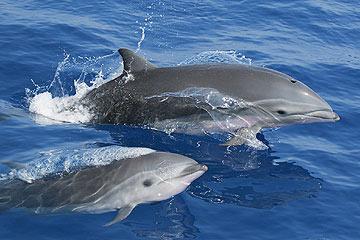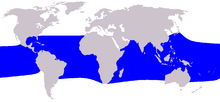Common Name: Fraser’s Dolphin
General Description: Fraser’s dolphins have a robust body, with a short but well-defined beak. The flippers are relatively small and pointed. The trailing edge of the tail flukes is concave. The dorsal fin is small, pointed and slightly sickle-shaped. There are marked keels above and below the tailstock.
Fraser’s dolphins are variable in coloration, but are generally dark grey to purplish black above. This colour forms a narrow cape or band of varying width along the back and tail stock. These dolphins are white or sometimes pink below. The lips and often the lower jaw may be white or flecked with white.

Size: Adults, average length of 2.3 m with a maximum of 2.6 m, average weight of 90 kg with a maximum of 136 kg.
Appearance At Sea: The swimming style of Fraser’s dolphin has been described as aggressive, with a spray created as the animal surfaces to breathe. They have not been seen bowriding but often leap as they travel alongside a vessel.
Fraser’s Dolphins have been observed in very large schools of up to 500. They may be found in the company of other cetaceans including spotted dolphins, pilot whales, Risso’s dolphins and sperm whales.
Found In: Fraser’s Dolphins are found offshore, and near coasts around oceanic islands. They are deep divers, feeding on squid, crustaceans and fish that are seldom found near the surface or those which rise to the surface at night.

Records from India: Fraser’s dolphins have been reported from the Andaman and Nicobar islands of India. This is one of those species that went unnoticed for very long, and was then discovered in large numbers at various areas. A group of 12 of these animals was seen off the east coast of Sri Lanka once in the early 1980s. Between 1984 and 1988, a few Fraser’s dolphins were landed in Sri Lankan fisheries.
World Distribution: Found in a number of areas of the Indian, Pacific and Atlantic Oceans, between latitudes 40°N and 40°S. They are relatively common in tropical oceans. There are no records from any waters cooler than 20°C.
Could Be Confused With: When seen clear of the water, the dark lateral stripe is distinct, and suggestive of the striped dolphins.There is also a possibility of confusion with common dolphins.
Diagnostic Features: At sea, their surfacing behaviour is distinctly boisterous, with an abrupt pointed snout, shortness of the fin, flippers and flukes and a dark lateral stripe.
Stranded Specimens: Fraser’s dolphins have a surprisingly large number of teeth in its abbreviated beak. There are 34 to 44 pairs of slender, pointed teeth in each jaw. The total is at least 160, often 172.




